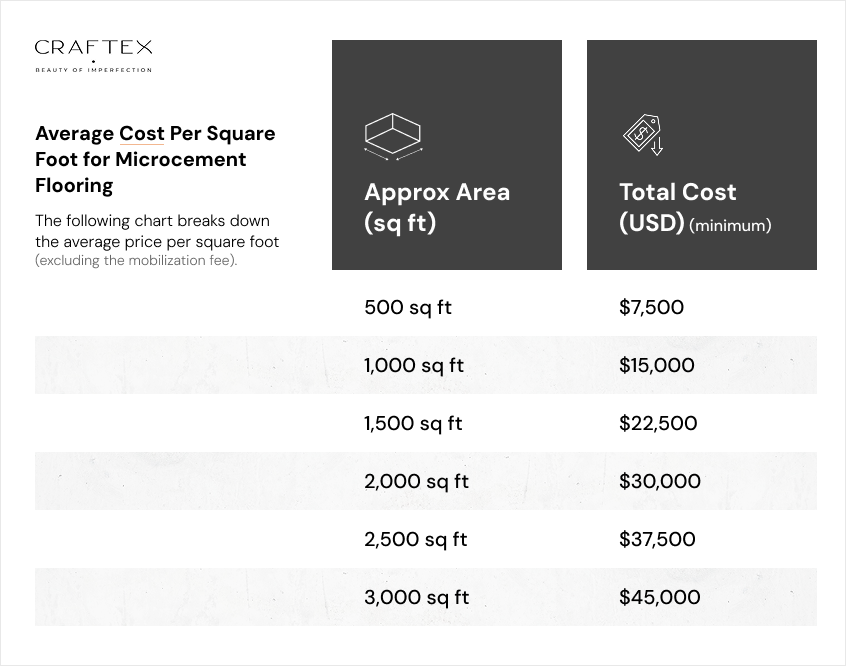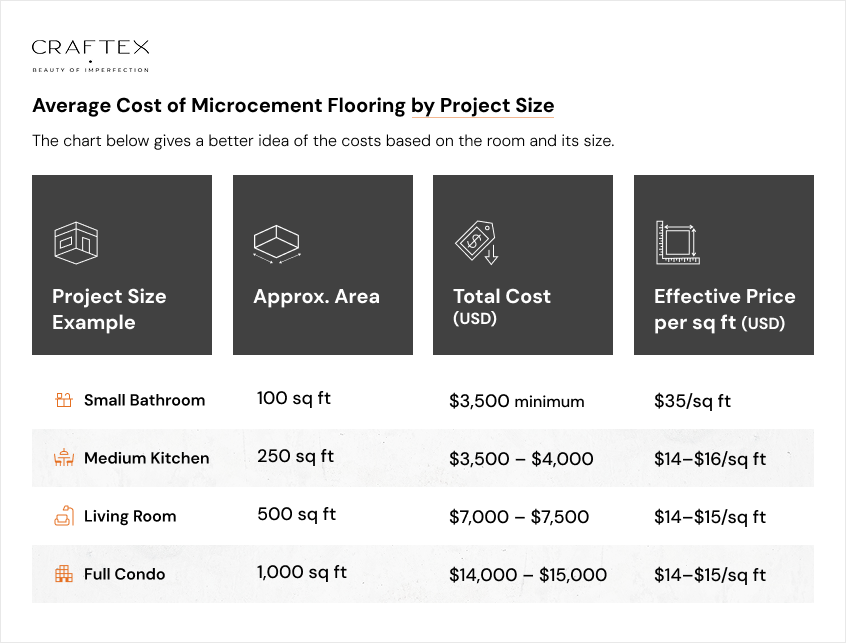Table Of Contents
Microcement is a material in construction that is growing in popularity. As more people embrace its versatility, low maintenance, durability, and polished look in their homes and businesses, its application has expanded to cover walls, countertops, and floors.
In this blog, we will discuss the cost of microcement flooring, its comparison to other flooring options, and factors that affect the cost.
Please note that the prices presented are based on research that was available at the time of writing. These are only estimates. For accurate quotes, you’ll need to contact your installer.
Average Cost Per Square Foot for Microcement Flooring
Microcement costs anywhere between $14 and $30 per square foot, with the average cost being $15 per square foot. Additionally, most contractors will require a mobilization fee that ranges between $3,500 and $4,000 for smaller jobs. Also, the cost of installing microcement flooring depends on factors like the size and complexity of the project, which will be discussed in detail later in this post.
The following chart breaks down the average price per square foot (excluding the mobilization fee).
Average Cost of Microcement Flooring by Project Size
Since complexity is determined by the type of room, the cost of microcement flooring varies based on the room, even when they share a similar square footage. This is due to the prep work, finishes, and top coats needed to add Microcement to different rooms.
The chart below gives a better idea of the costs based on the room and its size.
Microcement Flooring Cost vs. Other Flooring
Microcement flooring tends to require less prep work to install than other popular flooring options like vinyl plank, ceramic tile, and polished concrete. However, it tends to cost much more for a variety of reasons, discussed in the next section. The chart below shows the average installation cost per square foot of various flooring types compared to microcement flooring.
Factors that Affect Microcement Flooring Cost
As mentioned earlier, square footage is only one of several considerations when calculating the cost of microcement flooring. The floor’s complexity and condition, material color and quality, finishes and topcoats, labor, and seasonal and environmental factors also affect the cost of microcement flooring.
- Size of the Area
The size of the area you want to cover with microcement will affect the total cost. The bigger the space, the more microcement needed to cover the area, along with more labor hours for installation. - Complexity of the Area
The complexity of the area you’d like to add the new flooring to also impacts the final cost due to the increased labor. If the area has corners, niches, pillars, stairs, textured surfaces, window reveals, or other complex details, you can expect a higher total cost. - Conditions of the Floor Surface
Microcement is convenient because it can be applied over many other floor surfaces. However, if your floor is uneven or has cracks or other issues, these will need to be fixed before the microcement can be added. These extra steps of repairing, levelling, and conditioning will increase the cost of both labor and materials. - Quality of the Materials
The higher the quality of microcement, the higher the cost. However, it’s important to invest in microcement that falls within your budget without compromising on quality. Using substandard microcement can lead to cracks, chipping, and other damage that will cost you in the long run. - Color Selection
Microcement flooring is versatile. You can use it to make endless intricate designs using various colors. However, this means that extra labor, drying time, and protective layers will be needed, extending the project timeline and increasing costs. - Finishes & Top Coats
The types of finishes and top coats you select affect the final cost. If you opt for a sealant, which increases the floor’s durability and shine, additional labor and drying time will be needed. - Labor Cost
It is imperative that you hire an experienced professional trained in microcement application. This specialized skill means that the labor cost includes not only the actual labor but also the training, level of expertise, and years of experience. - Seasonal & Environmental Factors
The timeline for the completion of your microcement flooring will depend heavily on how quickly the floor can dry. If you start the project during the winter, the floor will take longer to dry and harden. Similarly, if the floor is located in a room or area that doesn’t receive much ventilation, the microcement will take longer to dry and harden.
Tips to Reduce Cost
Although the cost of microcement flooring is more than other flooring options, installation doesn’t have to break the bank. By being mindful of how certain factors can increase the cost, you can make decisions that meet both your aesthetic vision and your budget. Below are a few tips to reduce the cost of adding microcement flooring to your home or business.
- Reduce the number of pigments and patterns you go for.
This will reduce the materials and steps in the process, along with the labor cost. Also, consider whether you can go without certain luxury finishes and coats. - Time your project well.
Opt to install your microcement in warmer months so that the floor dries and cures quicker, reducing the project timeline. - Choose proper prep work and quality materials to begin with.
Although these may cost more upfront, the headache and cost of repairing issues down the line is just not worth it.
Wrapping Up the Costs of Microcement Flooring
Now that you know the costs associated with microcement, you can plan your flooring project better. Despite a higher upfront cost, microcement flooring is popular because it is durable and easy to maintain. It is visually appealing and adds a minimalist look to a room.
Get microcement ordered for your next remodel. With a wide range of colors and finishes to choose from, we’ll help you find the right selection for your needs.
Contact Craftex today and start flooring your home or business.



